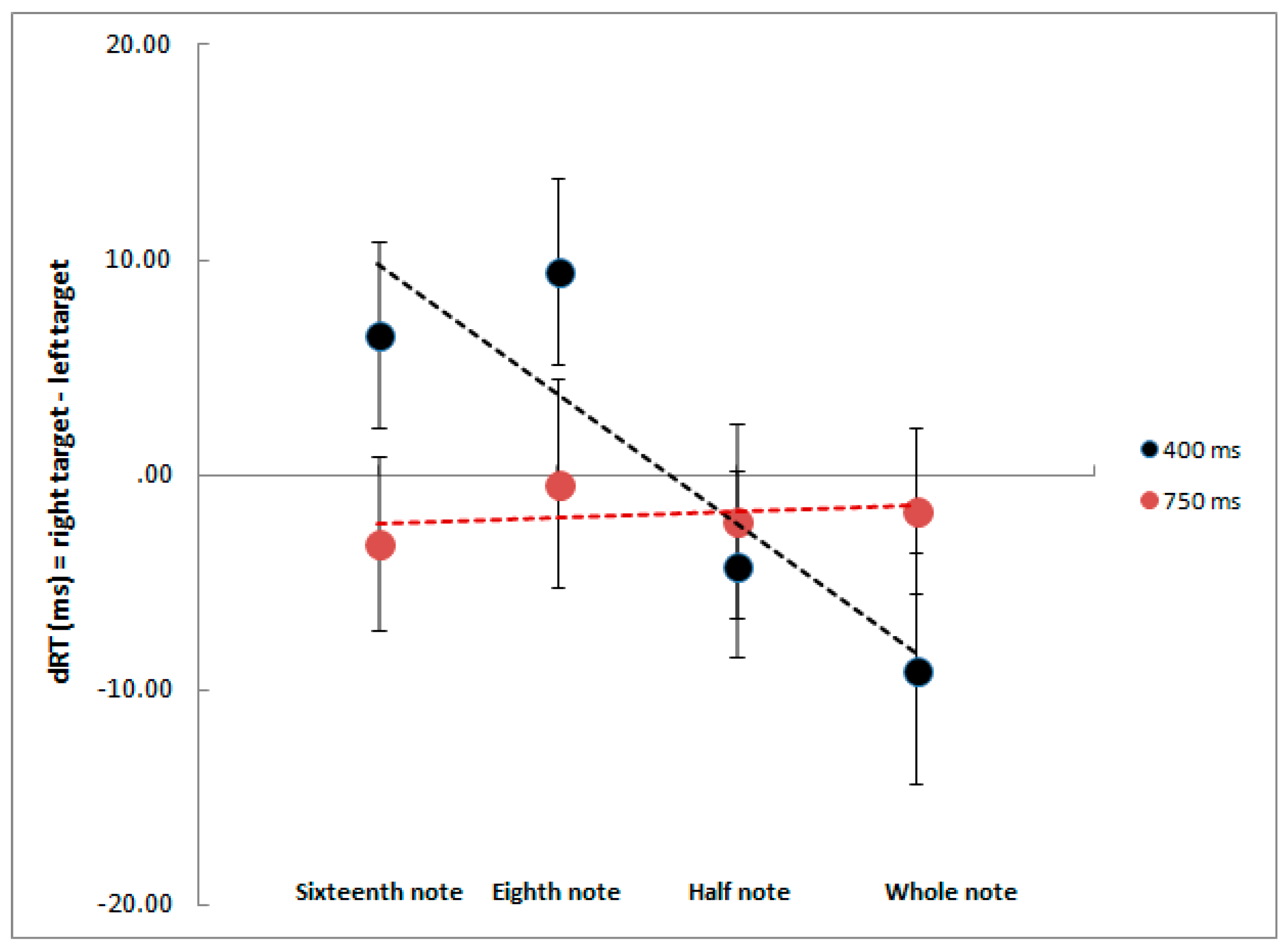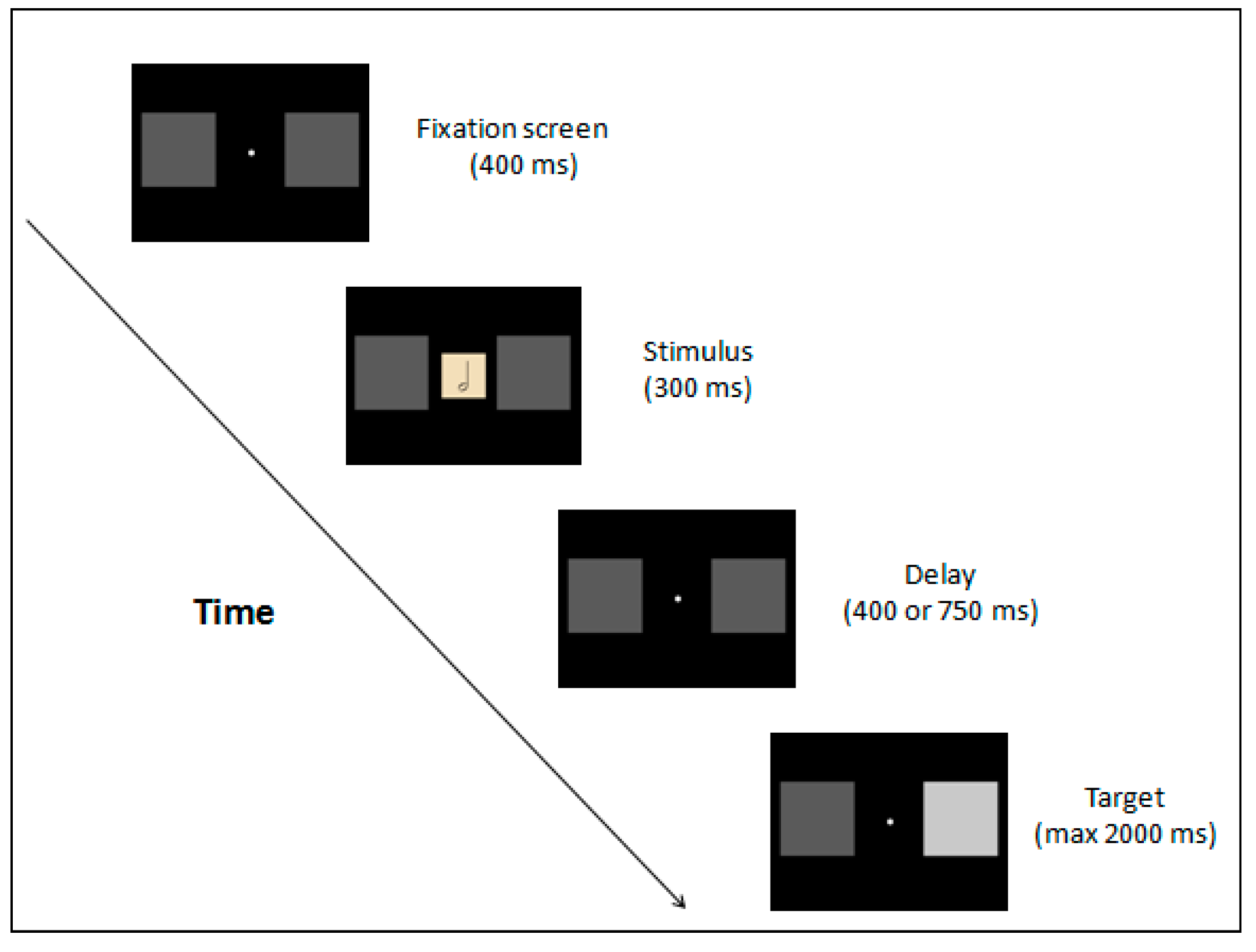Perceiving Musical Note Values Causes Spatial Shift of Attention in Musicians
Abstract
:1. Introduction
2. Results
3. Discussion
4. Materials and Methods
4.1. Participants
4.2. Apparatus and Stimuli
4.3. Procedure
Acknowledgments
Conflicts of Interest
References
- Dehaene, S.; Bossini, S.; Giraux, P. The mental representation of parity and number magnitude. J. Exp. Psychol. Gen. 1993, 122, 371–396. [Google Scholar] [CrossRef]
- Restle, F. Speed of adding and comparing numbers. J. Exp. Psychol. 1970, 95, 437–444. [Google Scholar] [CrossRef]
- Dehaene, S.; Dupoux, E.; Mehler, J. Is numerical comparison digital? Analogical and symbolic effects in two-digit number comparison. J. Exp. Psychol. Hum. Percept. Perform. 1990, 16, 626–641. [Google Scholar] [CrossRef] [PubMed]
- Fias, W.; Lauwereyns, J.; Lammertyn, J. Irrelevant digits affect feature-based attention depending on the overlap of neural circuits. Cogn. Brain Res. 2001, 12, 415–423. [Google Scholar] [CrossRef]
- Shaki, S.; Fischer, M.H.; Petrusic, W.M. Reading habits for both words and numbers contribute to the SNARC effect. Psychon. Bull. Rev. 2009, 16, 328–331. [Google Scholar] [CrossRef] [PubMed]
- Zebian, S. Linkages between number concepts, spatial thinking, and directionality of writing: The SNARC effect and the reverse SNARC effect in English and Arabic monoliterates, biliterates, and illiterate Arabic speakers. J. Cogn. Cult. 2005, 5, 165–190. [Google Scholar] [CrossRef]
- Rugani, R.; Vallortigara, G.; Priftis, K.; Regolin, L. Number-space mapping in the newborn chick resembles humans’ mental number line. Science 2015, 347, 534–536. [Google Scholar] [CrossRef] [PubMed]
- Rugani, R.; Salva, O.R.; Regolin, L. Lateralized mechanisms for encoding of object. Behavioral evidence from an animal model: The domestic chick (Gallus gallus). Front. Psychol. 2014, 5, 150. [Google Scholar] [CrossRef] [PubMed]
- Fischer, M.H.; Castel, A.D.; Dodd, M.D.; Pratt, J. Perceiving numbers causes spatial shifts of attention. Nat. Neurosci. 2003, 6, 555–556. [Google Scholar] [CrossRef] [PubMed]
- Galfano, G.; Rusconi, E.; Umiltà, C. Number magnitude orients attention, but not against one’s will. Psychon. Bull. Rev. 2006, 13, 869–874. [Google Scholar] [CrossRef] [PubMed]
- Ristic, J.; Wright, A.; Kingstone, A. The number line effect reflects top-down control. Psychon. Bull. Rev. 2006, 13, 862–868. [Google Scholar] [CrossRef] [PubMed]
- Bächtold, D.; Baumüller, M.; Brugger, P. Stimulus-response compatibility in representational space. Neuropsychologia 1998, 36, 731–735. [Google Scholar] [CrossRef]
- Van Dijck, J.P.; Fias, W. A working memory account for spatial–numerical associations. Cognition 2011, 119, 114–119. [Google Scholar] [CrossRef] [PubMed]
- Van Galen, M.S.; Reitsma, P. Developing access to number magnitude: A study of the SNARC effect in 7-to 9-year-olds. J. Exp. Child. Psychol. 2008, 101, 99–113. [Google Scholar] [CrossRef] [PubMed]
- Dodd, M.D.; Van der Stigchel, S.; Leghari, M.A.; Fung, G.; Kingstone, A. Attentional SNARC: There’s something special about numbers (let us count the ways). Cognition 2008, 108, 810–818. [Google Scholar] [CrossRef] [PubMed]
- Gevers, W.; Reynvoet, B.; Fias, W. The mental representation of ordinal sequences is spatially organized. Cognition 2003, 87, B87–B95. [Google Scholar] [CrossRef]
- Gevers, W.; Reynvoet, B.; Fias, W. The mental representation of ordinal sequences is spatially organized: Evidence from days of the week. Cortex 2004, 40, 171–172. [Google Scholar] [CrossRef]
- Ren, P.; Nicholls, M.E.R.; Ma, Y.Y.; Chen, L. Size matters: Non-numerical magnitude affects the spatial coding of response. PLoS ONE 2011, 6, e23553. [Google Scholar] [CrossRef] [PubMed]
- Fumarola, A.; Prpic, V.; Da Pos, O.; Murgia, M.; Umiltà, C.; Agostini, T. Automatic spatial association for luminance. Atten. Percept. Psychophys. 2014, 76, 759–765. [Google Scholar] [CrossRef] [PubMed]
- Fumarola, A.; Prpic, V.; Fornasier, D.; Sartoretto, F.; Agostini, T.; Umiltà, C. The Spatial Representation of Angles. Perception 2016, 45, 1320–1330. [Google Scholar] [CrossRef] [PubMed]
- Hartmann, M.; Mast, F.W. Loudness counts: Interactions between loudness, number magnitude and space. Q. J. Exp. Psychol. B. 2017, 70, 1305–1322. [Google Scholar] [CrossRef] [PubMed]
- Hoffmann, D.; Goffaux, V.; Schuller, A.M.; Schiltz, C. Inhibition of return and attentional facilitation: Numbers can be counted in, letters tell a different story. Acta. Psychol. 2016, 163, 74–80. [Google Scholar] [CrossRef] [PubMed]
- Fattorini, E.; Pinto, M.; Merola, S.; D’Onofrio, M.; Doricchi, F. On the instability and constraints of the interaction between number representation and spatial attention in healthy humans: A concise review of the literature and new experimental evidence. Prog. Brain Res. 2016, 227, 223–256. [Google Scholar] [CrossRef] [PubMed]
- Prpic, V. SNARC-Like Effects for Visual and Auditory Musical Stimuli: The Relation Between Space and Different Music Parameters. Ph.D. Thesis, University of Trieste, Trieste, Italy, 14 April 2014. [Google Scholar]
- Rusconi, E.; Kwan, B.; Giordano, B.L.; Umiltà, C.; Butterworth, B. Spatial representation of pitch height: The SMARC effect. Cognition 2006, 99, 113–129. [Google Scholar] [CrossRef] [PubMed]
- Lidji, P.; Kolinsky, R.; Lochy, A.; Morais, J. Spatial Associations for Musical Stimuli: A Piano in the Head? J. Exp. Psychol. Hum. Percept. Perform. 2007, 33, 1189–1207. [Google Scholar] [CrossRef] [PubMed]
- Timmers, R.; Li, S. Representation of pitch in horizontal space and its dependence on musical and instrumental experience. Psychomusicol. Music Mind Brain 2016, 26, 139–148. [Google Scholar] [CrossRef]
- Pitteri, M.; Marchetti, M.; Priftis, K.; Grassi, M. Naturally together: Pitch-height and brightness as coupled factors for eliciting the SMARC effect in non-musicians. Psychol. Res. 2017, 81, 243–254. [Google Scholar] [CrossRef] [PubMed]
- Ishihara, M.; Keller, P.E.; Rossetti, Y.; Prinz, W. Horizontal spatial representations of time: Evidence for the STEARC effect. Cortex 2008, 44, 454–461. [Google Scholar] [CrossRef] [PubMed]
- Prpic, V.; Fumarola, A.; De Tommaso, M.; Baldassi, G.; Agostini, T. A SNARC-like effect for music tempo. Rev. Psychol. 2013, 20, 47–51. [Google Scholar]
- Bonato, M.; Zorzi, M.; Umiltà, C. When time is space: Evidence for a mental time line. Neurosci. Biobehav. Rev. 2012, 36, 2257–2273. [Google Scholar] [CrossRef] [PubMed]
- Chiou, R.; Rich, A.N. Cross-modality correspondence between pitch and spatial location modulates attentional orienting. Perception 2012, 41, 339–353. [Google Scholar] [CrossRef] [PubMed]
- Prpic, V.; Fumarola, A.; De Tommaso, M.; Luccio, R.; Murgia, M.; Agostini, T. Separate mechanisms for magnitude and order processing in the spatial-numerical association of response codes (SNARC) effect: The strange case of musical note values. J. Exp. Psychol. Hum. Percept. Perform. 2016, 42, 1241–1251. [Google Scholar] [CrossRef] [PubMed]
- Fias, W.; Brysbaert, M.; Geypens, F.; d’Ydewalle, G. The importance of magnitude information in numerical processing: Evidence from the SNARC effect. Math. Cog. 1996, 2, 95–110. [Google Scholar] [CrossRef]
- Luccio, R.; Fumarola, A.; Tamburini, G.; Agostini, T. The spatial representation of non-symbolic numerical quantities. Proceedings of Fechner Day, Ottawa, ON, Canada, 18–21 October 2012; pp. 321–327. [Google Scholar]


© 2017 by the author. Licensee MDPI, Basel, Switzerland. This article is an open access article distributed under the terms and conditions of the Creative Commons Attribution (CC BY) license (http://creativecommons.org/licenses/by/4.0/).
Share and Cite
Prpic, V. Perceiving Musical Note Values Causes Spatial Shift of Attention in Musicians. Vision 2017, 1, 16. https://doi.org/10.3390/vision1020016
Prpic V. Perceiving Musical Note Values Causes Spatial Shift of Attention in Musicians. Vision. 2017; 1(2):16. https://doi.org/10.3390/vision1020016
Chicago/Turabian StylePrpic, Valter. 2017. "Perceiving Musical Note Values Causes Spatial Shift of Attention in Musicians" Vision 1, no. 2: 16. https://doi.org/10.3390/vision1020016
APA StylePrpic, V. (2017). Perceiving Musical Note Values Causes Spatial Shift of Attention in Musicians. Vision, 1(2), 16. https://doi.org/10.3390/vision1020016




